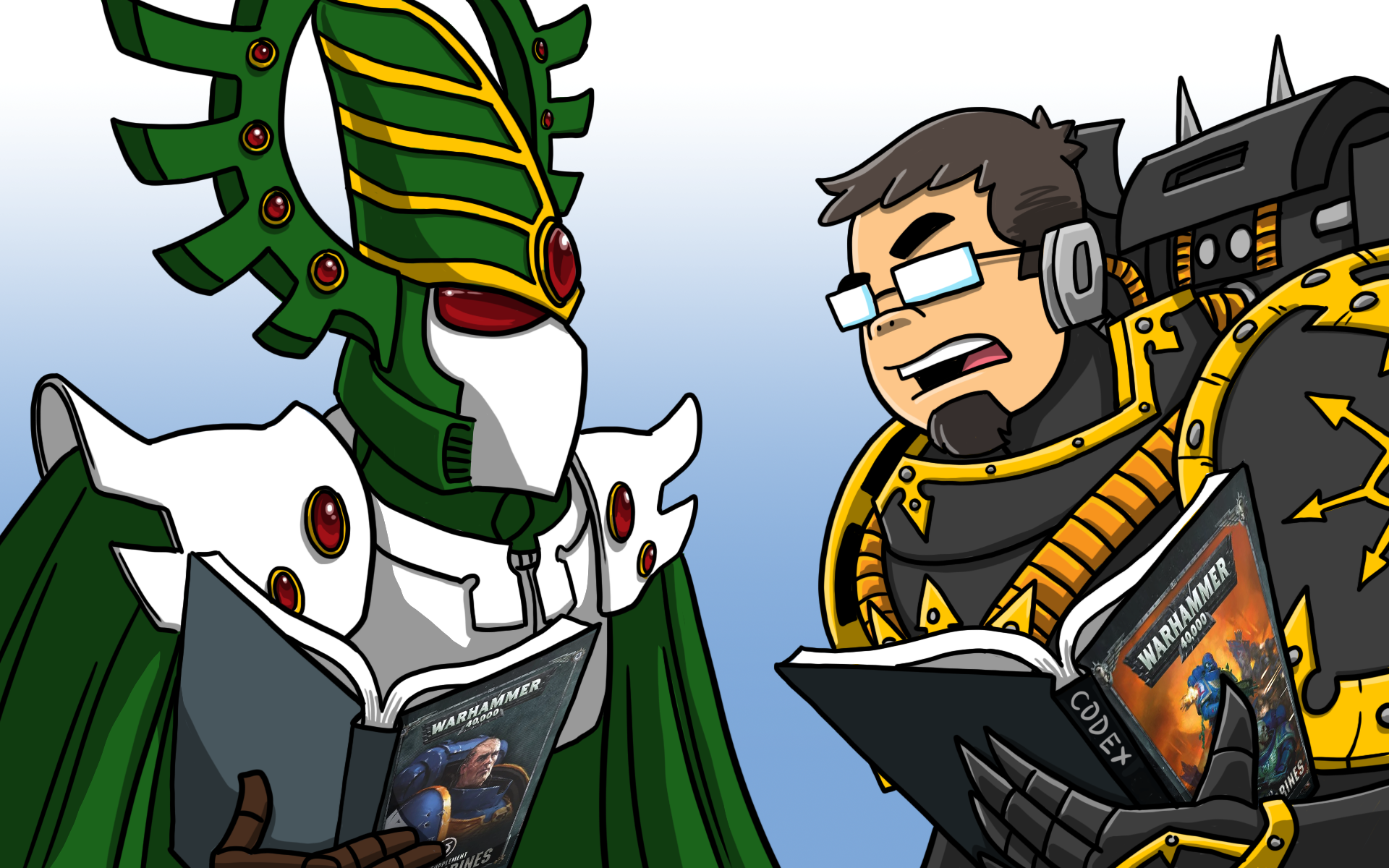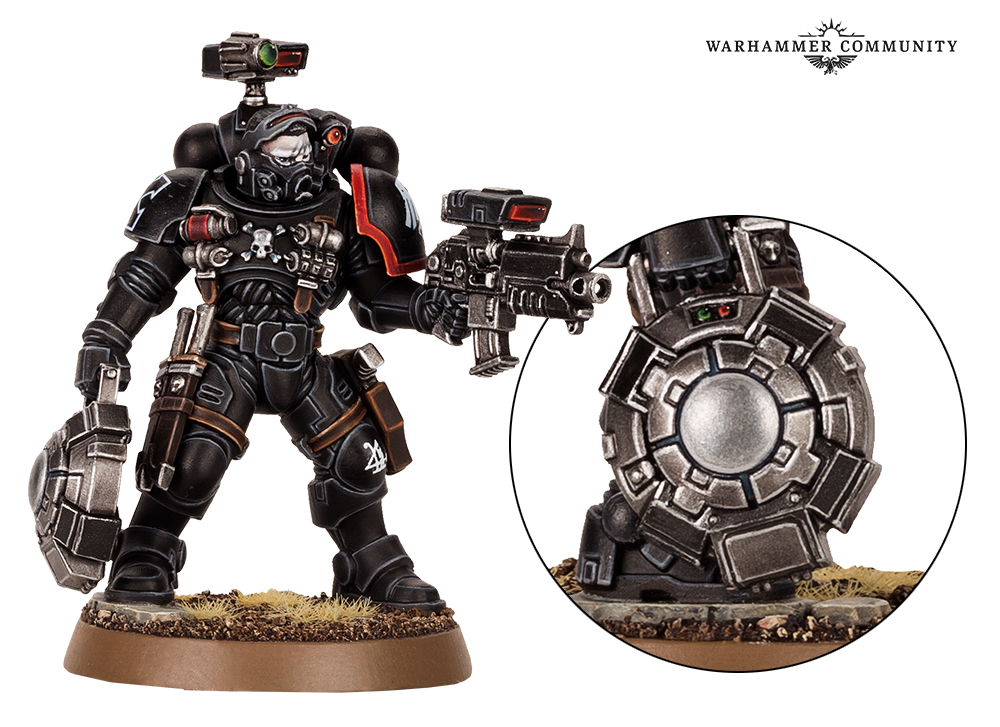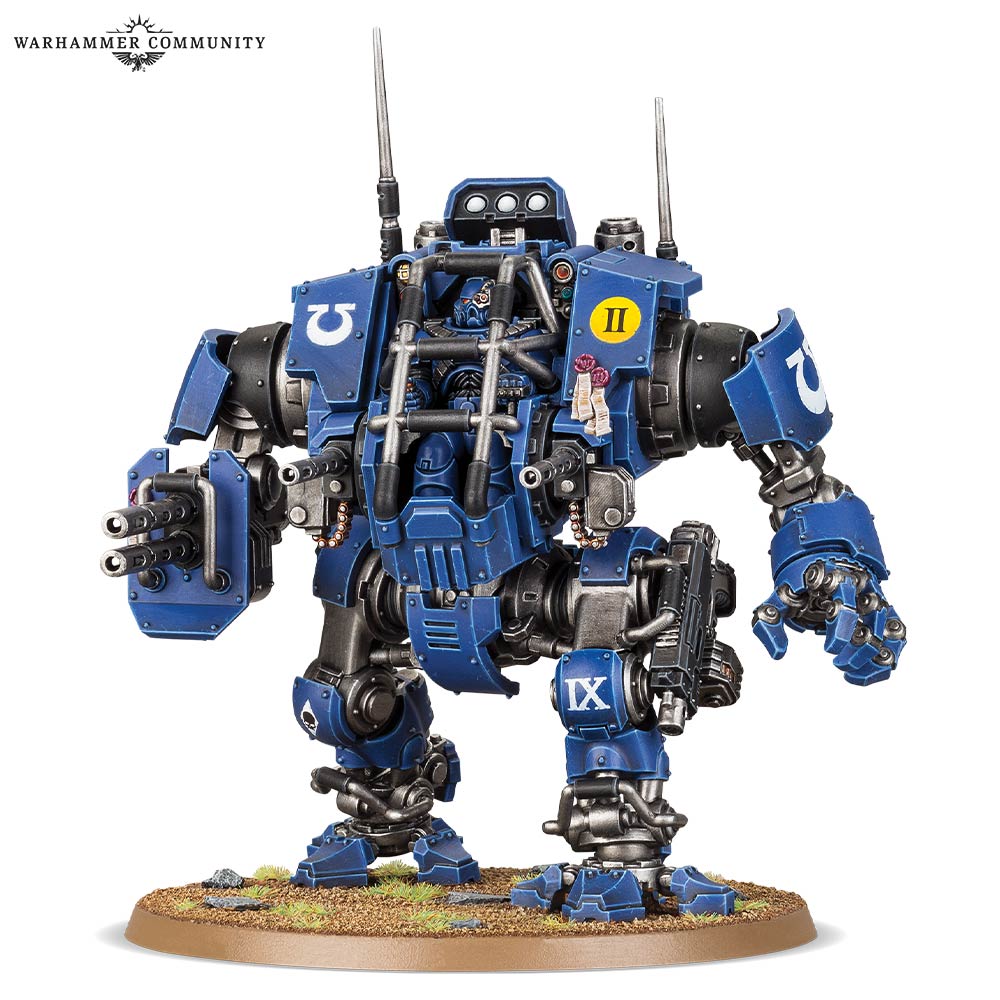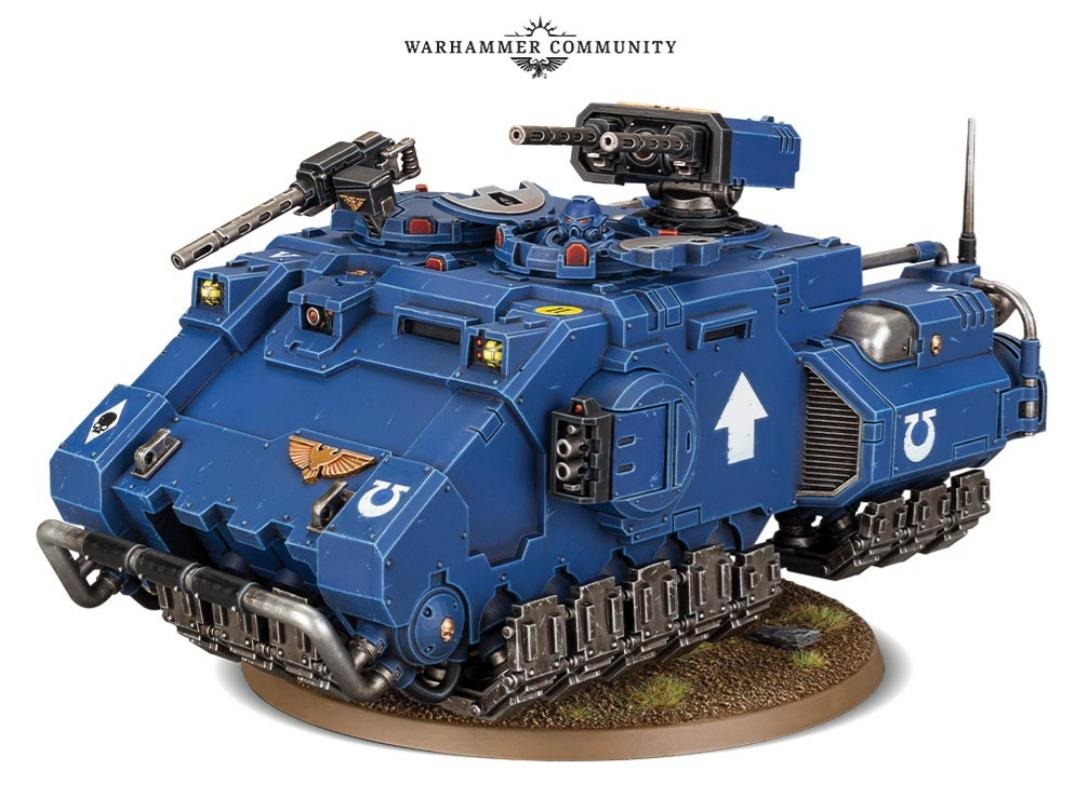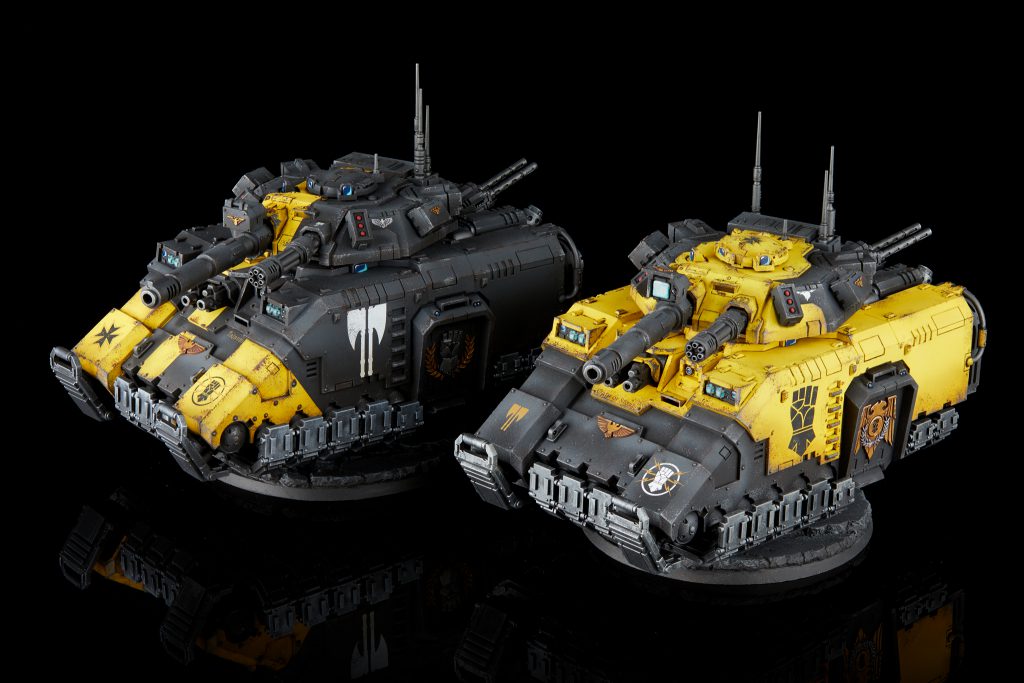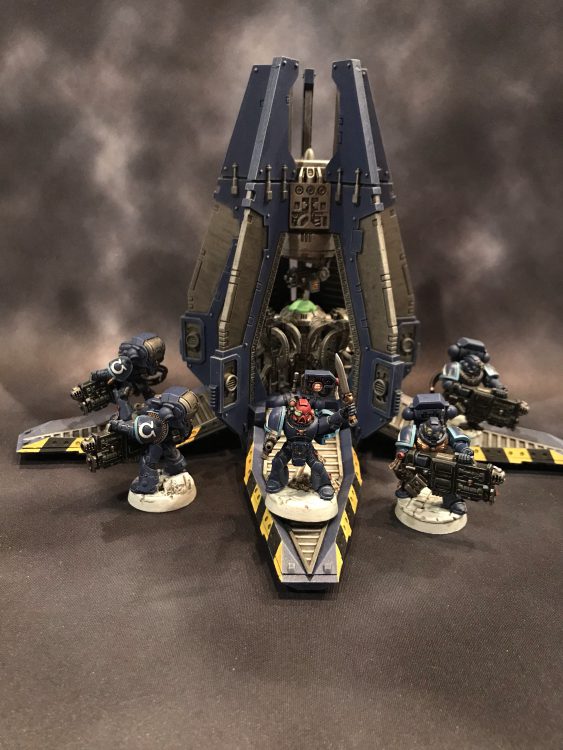In case you missed Part 1 of our Codex: Space Marines Review, you can find it here.
We really wanted to keep our review of Codex: Space Marines to a single article, but the book is just so damn massive (192 pages just for the base book, never mind the supplements!) we had to split it into three parts. After thirty years of Codexes and new units, Space Marines are easily the game’s most overstuffed faction. So this time around, we’ll be talking about the book’s units, both those newly introduced with this release and the old ones that have been improved. If you want to read about the new army-wide rules, click the link above. Otherwise, stick with us as we dive further into the book.
The New Units
The majority of the “new” units in Codex: Space Marines aren’t, strictly, new. Although they were 8th edition’s first codex, Space Marines have had a steady drip-feed of new releases over the past two years, recently adding Primaris Vanguard units from Shadowspear and the Repulsor Executioner to bolster their ranks. Some of the new model releases accompanying this codex release are the Shadowspear units getting a multipose treatment and being split up into separate kits, but there’s also a small number of brand new options. We’ll take a look at these first. Note that we’re counting a couple of Shadowspear units that have received new builds as new units, as the spirit of this section is covering options that weren’t available to the army before.
HQ
Lieutenant in Phobos Armour
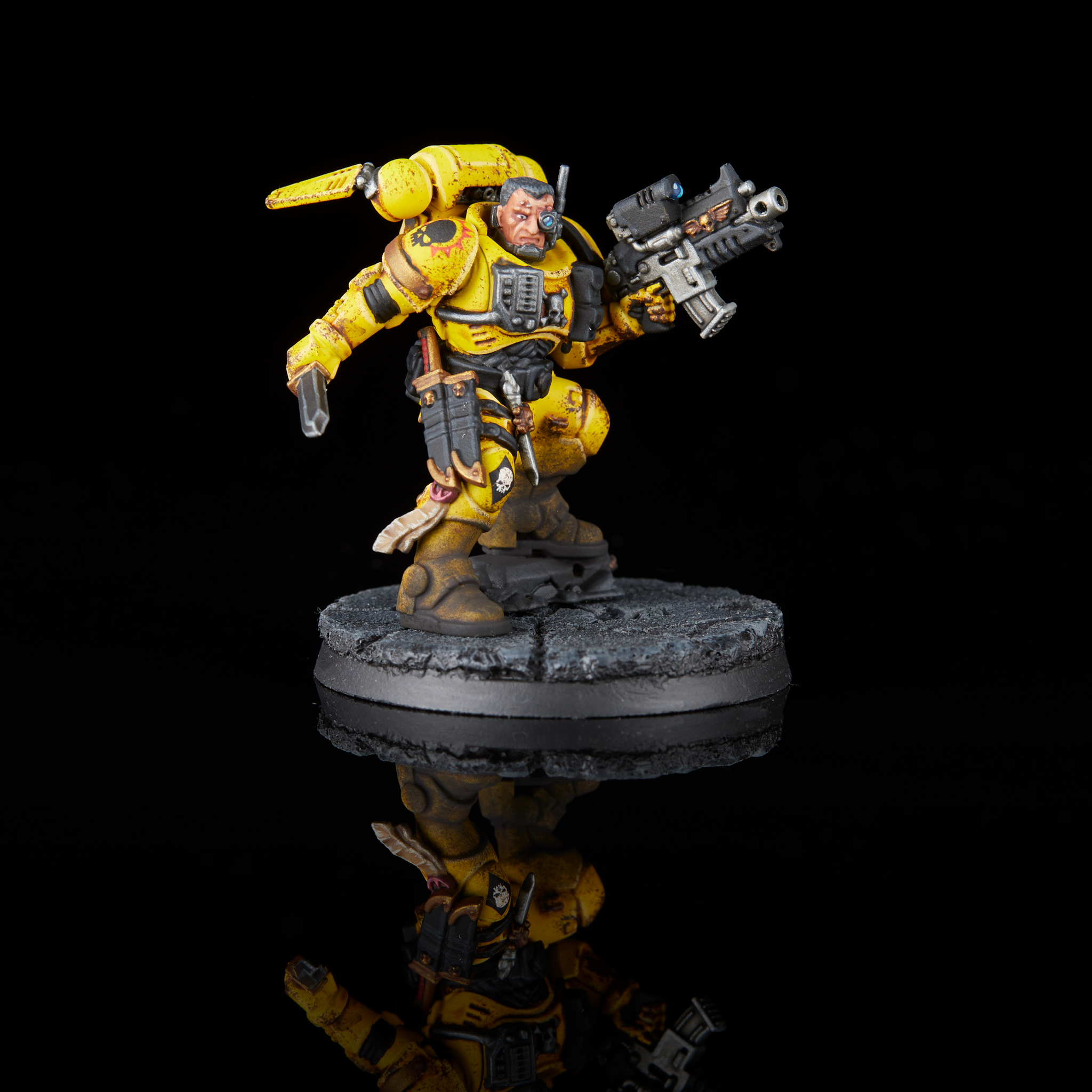
This guy gets a second equipment build. Instead of the Shadowspear options (Grav Chute, Occulus Carbine, Combat Blades) you can equip him as a souped-up Reiver, taking a Combat Knife, Heavy Bolt Pistol and Smoke Grenades. This adds the Reiver keyword and the Terror Troops ability, as well as Smoke Grenades. The Smoke Grenades (use in the shooting phase to give -1 to hit against him until your next turn) are kind of pointless on a character (although OK if he ends up out of position), but now that Terror Troops stacks multiple times and Reivers are a bit cheaper, having a model that can deploy it where needed has some advantages. Because you don’t have to pay for the Grav Chute, this also ends up as the cheapest way to get a Phobos character on the field, so if you just want a cheap Lieutenant on the field to carry the “Target Priority” trait around, this is a model you want access to.
Troops
Incursors
A new addition to the Phobos/Vanguard range, Incursors are a slightly cheaper option for getting Primaris Marines with Vanguard deployment onto the battlefield. Compared to the infiltrators, they lose the Omni-scramblers (the wargear which forces enemy units to deploy more than 12″ away if arriving on the table after turn 1), and they carry an occulus bolt carbine instead of the marksman bolt carbine their chapter brothers use. This ignores cover on things they’re shooting at and they also have a multi-spectrum array that causes them to ignore hit and Ballistic Skill modifiers. Finally, a single model can take a Haywire Mine, which they can place during the Movement phase as they move. When enemy units move over the mine, it explodes and they have a chance to suffer D3 mortal wounds (D3+1 for a vehicle). This delightful thing is pictured above, and the kit includes a separate option to place it on the table.
TheChirurgeon’s Note: While the mines are likely to be less useful against Infantry that can move around them, they still affect Aircraft, which are often locked in to specific movement patterns thanks to minimum move distances and limited turning. I like these a lot for either forcing flyers to move away or punishing an opponent’s flyers for trying to get up your business when you can predict where they’ll have to move next.
These seem like an interesting option. We’re slightly surprised not to see Infiltrators get a points drop, as they haven’t really been seeing much play. Pushing a bunch of Primaris bodies into your enemy’s face early on is a fundamentally attractive prospect, especially with all the upgrades Marines get, and these are a cheaper way of doing it. They’re notably less good at chipping wounds of enemy vehicles than Infiltrators thanks to the lack of auto-wounds on 6s to hit, but better at putting the hurt on chaff infantry huddling in Prepared Positions.
What these are going to be great for is including a squad in your army and parking on a far off objective. Whether the mine works for that or not is something of a toss up – we’re inclined to think keeping these cheap and cheerful is best, but it’s possible threatening anything that comes to melee them with some mortals is worth it. When using a squad for this, they’re also a great target for the Transhuman Physiology stratagem, as if your opponent commits something like a Hemlock to try and prise them out of their cover it can partially blunt its assault for a turn.
We like this new option, and expect to see them get some serious testing.
Elites
Invictor Tactical Warsuit
Stealth Dreadnought? Stealth Dreadnought!
OK, technically not actually a DREADNOUGHT, but we all know the truth. This is potentially the most exciting addition to the range in the release, because it gets around the perennial problem of Dreadnoughts – getting them into battle alive. It shares “Vanguard Deployment” with the Phobos troop choices, and starting 9″ away from the enemy/their deployment zone forces them to either backline heavily, or deal with powerful mech punching stuff out from turn 1.
This thing is also priced to move. You pick from either a twin ironhail autocannon or an incendium Cannon, and end up at 136 or 131 points, respectively. That’s great value for a threat that demands immediate answers – this thing has 5 attacks on the charge, and its fist gets flat 3 damage (generally one of the most coveted damage profiles because of how reliable it is), meaning it can absolutely trash vehicles in the fight phase. The ironhail autocannon can help go after larger targets, but as it doesn’t ignore the move/shoot penalty (and suffers from a degrading BS), we think the incendium cannon (effectively a dual heavy flamer with 12″ range) is the more exciting choice in most use-cases. There are also other options for backline shooting platforms, whereas the incendium build is kind of unique. Don’t forget that you’ll also be in Devastator doctrine turn 1, so that heavy flamer and most of the other guns are going to have +1 AP when the game kicks off, helping this thing start scything through infantry early on in between punching tanks.
The only thing you have to remember about this is that it isn’t indestructible, and if you’re going to get under-dropped or are playing a mission where you know you’re likely going second in deployment you need to be a bit more cautious with how you place it – consider dropping it (or maybe a clutch of them) on a mid-field objective rather than right in the enemy’s face. Watch out for avenger gatling cannons and heavy burst cannons too – a lot of the time T6 compared to T7 won’t matter, but you want to try and avoid these being pointed at you.
These things seem fantastic, so expect to see groups of them out and about on a table near you very soon.
Heavy Support
Eliminator Squad

These aren’t completely new, but they’ve had a substantial tune up and gained a very interesting new weapon choice, so they may as well be.
These were already OK on their existing statline: they’re a complete pain to shift from cover, they’re not super expensive, and they can threaten to spike a character with a good round of shooting. There’s a reason these showed up in competitive lists, as their biggest downsides are pretty much being a Heavy Support choice and only coming in squads of 3.
Eliminators received some big improvements:
- Better Sniper Bolt Rifles. First of all, the strength of their “default” bolt sniper rifle improved to S5 on all three shooting profiles. This makes them quite a bit more dangerous to T4 armies, which also helping chip the odd wound off larger vehicles like Knights. Additionally, you can target characters with all three profiles now, giving you a great spread of options to choose from to really put the hurt on a key buff character.
- New Sergeant Options. Secondly, you now have the option of taking an instigator bolt carbine on the sergeant. This has a shorter range than the rifles and lacks the mixed firing options, but means that after the squad fires Overwatch they can immediately move 6″, making it very difficult to pin them into melee. The sergeant also gains a new ability that can make up for him sometimes not getting to fire if you choose this option – he can sacrifice firing to give the rest of the squad +1 to its hit and wound rolls. This can be very good in some situations: If you’re pointing Mortis rounds at a large vehicle, you get more damage by using this mode than by firing three shots from the squad, and 2D3 buffed Hyperfrag rounds are only a hair’s breadth behind 3D3 regular shots when going into a horde. That means the opportunity cost of buying the carbine is pretty low, and since “punked in melee” is often how these Eliminators go down, a useful upgrade. It also serves an additional purpose…
- Alternate Weapon Loadouts. The squad has a new build option: Instead of the rifles you can now swap the squad over to Las-fusils. These give each model a pulse laser equivalent shot (S8, AP -3, 3 Damage) and while the extra 12pts per model is spendy, in context it’s still a relatively cheap way to get some pretty hefty anti-tank firepower. This build is also where the ability to flex what the sergeant has comes into its own – against both T7 and T8 vehicles, two buffed fusil shots works out to more wounds than three unbuffed ones, so you may as well keep the sergeant a bit cheaper, and at that point buying the carbine for some defence against charges is probably worth it.
- Devastator Doctrine. Finally, all of the Eliminators’ weapons choices save the Carbine are Heavy, which means that they’ll benefit from Devastator Doctrine being active turn 1. Bolt Sniper Rifles picking out enemy characters at S5 AP-2 is pretty good!
All these fancy new tricks combine to make this a fantastic unit – even decked out with the carbine and 2 las-fusils build they weigh in at under 100 points, and they’re a complete nightmare to shift out of cover. They still suffer from only being able to take squads of 3, but they’re a damn good unit.
Expect to see these a lot. Or not to see them, depending on how well your opponent has done the camo paint.
Dedicated Transport
Impulsor
Long had the players of Marines cried out: “Please, GW! Please just give us a Primaris Rhino!” And lo GW hath answered with, uh, a Primaris Razorback. Close enough! The Impulsor is a cheap and effective way of transporting up to 6 Primaris Marines to the front lines, and while it’s a mild disappointment that Aggressors can’t ride in it, Intercessors, Reivers and Hellblasters are all too happy to hop in. Much like the recently released Skorpius Dunerider for Adeptus Mechanicus, the Impulsor is a “true” transport – it can mount a few offensive options, but what you’re paying for is the cheap way of transporting units to where they need to be. Luckily it’s very good at that.
At its barest bones it’s a 79-point model for a T7 3+ 11W model with a very nippy 14″ move, the FLY keyword, and the exciting new Assault Transport rule. This allows units inside it to disembark after it moves (as long as it doesn’t Advance), making it extremely good at getting your stuff where it needs to be. The units inside can’t assault, but since the most likely passengers (Intercessors and Hellblasters) are packing Rapid Fire weapons, getting them into position is crucial. The transport can then potentially go on to launch a charge, tying up enemy units and protecting your troops from retaliation.
It’s worth calling out that there is some debate on the internet as to whether the disembarking models can make a normal move after they climb out. The FAQ would seem to indicate that they can’t, and this would be broadly in line with similar effects out there, but it also seems likely that this would be explicitly called out in the ability if they couldn’t. This is one of those spots where everyone will immediately have an opinion on this, be unreasonably angry about it, and we’ll all find ourselves waiting on the FAQ to provide final clarification.
In terms of armaments, the basic loadout has two storm bolters, which you could switch for fragstorm launchers (but you shouldn’t). You can stick an ironhail heavy stubber on it (fine if you have the points free), and get some optional things you can mount on the back (if you want it to be proper Razorback-like). These are:
- Bellicatos Missile Array: It’s a missile launcher with an extra anti-air option. Given that you want to be on the move with this tank, it’s a marginal upgrade at best – spend your points on better gunline stuff elsewhere.
- Ironhail Skytalon Array: An anti-air twin ironhail heavy stubber. Has the benefit of being extremely cheap at only five points, so even though it gets a penalty to hit against ground targets, if you were already going to buy the ironhail upgrade and don’t want one of the other back mounts, you may as well go for this.
- Shield Dome: Gives the tank a 4+ invulnerable save. At 18 points, this is quite likely to be worth it if you’re loading it with Hellblasters – your opponent is going to point everything they’ve got at your tank, and this upgrade will probably pay for itself in terms of the firepower absorbed against a lot of armies.
- Orbital Comms Array: The real wildcard of the pack. Each Impulsor with one of these can launch a single orbital strike per game (max one per turn). Having this available as wargear is a very new thing which makes it difficult to evaluate, but it’s certainly at least interesting. It’s cheap enough that having one available to launch turn 1 seems pretty good – it potentially forces an opponent to disrupt their normal deployment plans to minimise the impact of it, and anything that makes an opponent make tricky decisions is good in our book. The option of taking more promises a seductive dream of launching one of these a turn, but we think that’s likely a trap. Ultimately, if you do that you’re under pressure to keep these out of trouble, and while they’re pretty cheap, they’re too expensive to buy just to hold in the backline for launching orbital strikes. If the Impulsors are in your opponent’s face, they’ll likely be destroyed anyways, and at that point you run a real risk of paying for an upgrade that has done nothing.
In summary, we think you should probably consider a single comms array for your first Impulsor, buy a Shield Dome for any Impulsors transporting Hellblasters, and stick the ironhail skytalon array on the rest.
The last neat thing about the Impulsor is that it has the Gravitic Backwash ability standard to the Repulsor and Caladius chassis, subtracting 2″ from enemy charges that target it. Because they’re the kind of thing you’re likely to have in multiples, in matchups like Orks where turn 1 redeploys matter, screening out a castle with a few of these is a real option. Obviously at the point you’re doing that, probably line up the Impulsors’ passengers 7-8 inches back; you don’t want to get caught out by a lucky 11″ charge and have a transport wrapped and killed.
The Impulsor has the potential to be a game-changer for Space Marines. Anyone who’s been following Naramyth’s AdMech tournament reports will know how much the Skorpius has added to that range, and this sits in a similar price range and opens up a tonne of new options for Primaris armies. A big hit.
Improved Units
Of course, there’s more to the book than the new units. Plenty of older units received substantial points changes, and all of the army’s units received the benefit of Angels of Death, Combat Doctrines, and upgraded Chapter Tactics, any one of which could massively change a unit’s viability. Note that in this article we’re only going to cover the units in Codex: Space Marines. There are a ton of units to go through and trying to cover Forge World too would be too much. Instead they’ll be covered in part 4.
Before we dive in on a unit-by-unit basis, here’s the general rub: Most of the units that were already good, got better. Some of the units who were on the edge of playability got the boost they needed. Most of the units that were bad are better, but they’re still usually outclassed by the good units that got better. So while Angels of Death made bad things not so bad, it helped out the units you’re going to take instead of those units as well. Don’t get too excited for Assault Marines just yet.
HQ
Note that all characters are beneficiaries of Shock Assault. Space Marines characters love punching, and now they are better at it than ever. In addition to the boost from Angels of Death and Doctrines improving the AP of characters across the board, also note the following changes to specific units:
- Captain in Phobos Armour: Received a major points drop – 20 pts. More limited in armament than the Primaris Captain, but now a good option to let you start with a Captain or Chapter Master aura far forward in the field – perhaps supporting some Warsuits. He’s also a good choice for grabbing (the superior) Vanguard Warlord Traits such as Lord of Deceit. His gun also got quite a bit better, becoming Assault and damage 3. Given he can target characters, that makes him great for softening/finishing off a target for some Eliminators.
- Captain in Gravis Armour: Gravis Captains got +1 Wound, upping their base total to 7. That’s a big bump, and increases the lifespan of Gravis Captains significantly. With Angels of Death and a boost from Might of Heroes, Gravis Captains can do real damage if you can get them into combat reliably.
- Librarians: Librarians received minor points cuts across the board. Ultimately, their value will be somewhat tied to the quality of the powers in the chapter supplement you have access to, though the big winner here is the Librarian in Phobos Armour, whose cost dropped by 10 points and who has access to better powers: the Obscuration Discipline has some cool powers in it for supplementing some of the strong new units Marines get.
- Lieutenants: Lieutenants, both in and out of Phobos Armour, received slight points decreases.

Let’s Talk About Chaplains
Of all the HQ choices in the Marines Codex, Chaplains got the largest change. Like their Dark Apostle counterparts received back in April when the new Codex: Chaos Space Marines dropped, Chaplains got their own set of prayers called Litanies to bolster nearby units. Litanies work the same way for Chaplains as they do for Dark Apostles, activating at the start of each Battle Round on a D6 roll of a 3+, although unlike Apostles, Chaplains don’t have disciples to boost their rolls, but make up for it by being substantially cheaper than their traitor cousins. Chaplains and Primaris Chaplains know Litany of Hate (re-roll hit rolls for melee attacks made by <CHAPTER> units within 6″ of this model) and one additional litany chosen from a list.
They’re pretty good:
- Litany of Faith – When friendly <CHAPTER> units within 6″ suffer a mortal wound, roll a D6. On a 5+, they ignore that wound. Doesn’t stack with other abilities.
- Catechism of Fire – Pick a friendly <CHAPTER> unit within 6″. That unit gets +1 to its To Wound rolls when it shoots the closest unit.
- Exhortation of Rage – Pick a friendly <CHAPTER> unit within 6″. When that unit fights, unmodified 6s give you another attack with the same weapon. The new attacks don’t cause further attacks.
- Mantra of Strength – Add 1 to the Chaplain’s Strength and Attack characteristics and 1 to the Damage characteristic of its melee weapons.
- Recitation of Focus – Pick a friendly <CHAPTER> unit within 6″. Add 1 to the To Hit rolls of that unit’s attacks made with ranged weapons.
- Canticle of Hate – Add 2 to charge rolls for friendly <CHAPTER> units within 6″ of this model and friendly <CHAPTER> units within 6″ can move 6″ when they pile in or consolidate. Doesn’t stack with other abilities that increase these ranges.
Like we said, pretty good. You can’t use (or attempt) the same Litany more than once per battle round, so no doubling up, and you’ll often want to hold a CP to re-roll your litanies in case they don’t work (and remember this takes place outside of a phase, so doesn’t “use up” your re-roll for any other part of the turn). Of these, Litany of Faith is the only real loser, though even that has situational use if you find yourself up against armies running lots of Smite. Mantra of Strength might be useful on a Chaplain sporting the Benediction of Fury relic to turn him into a 4-damage buzzsaw. Canticle of Hate is theoretically very good, helping to smooth out charge rolls, but bear in mind that because the Chaplain has to be on the board at the start of the battle round to activate it you can’t just bring a Terminator Chaplain in and go wild – boosting deep strikers takes some setup. Catechism of Fire is very powerful and worth working with, but will require some work to make sure you can pick the targets you want.
Ultimately, however, the big, big, winner is Recitation of Focus – now Target Priority is PHOBOS only this takes its place as a generic way to boost up the output of one of your ranged units, and we expect to see this deployed alongside big gunline units like Dreadnoughts and Repulsors very often.
A final thing worth remembering when looking at this list is, unlike for Chaos, there’s at least one model (Chaplain Cassius) who knows two of these. That substantially ups his flexibility, and as more of the books drop it’s definitely worth double checking any of the other named Chaplains that come along for the same effect.
Troops
- Intercessors: Intercessors stayed the same cost, but are now bringing a lot more to the table. Most notably, auto bolt rifles gained an extra shot, and having Assault 3 guns with a 24″ range for 1 point per model is pretty great, especially when you combine it with a Chapter Tactic that lets you ignore the penalty for advancing and firing. You factor in the ability to make these guys Veterans, plus Tactical Doctrine and Shock Assault, and you’ve got a unit that can be fantastic all-rounders no matter what you want to do with them. The only downside is the price, but for everything they can do, they’re still a bargain. In addition, the Sergeants get the option of taking a thunder hammer now, which given they’ll be four attacks on the charge (or five if you make them Veterans) is pretty tasty – a unit sergeant that can randomly trash a tank is a great surprise to have in your lines (or bundled into an Impuslor).
TheChirurgeon’s Note: As a Chaos Marines player, I am extremely mad that Noise Marines pay 4ppm for sonic blasters to do the same thing as auto bolt rifles but with ignores cover tacked on.

- Tactical Marines: A 1 point-per-model decrease in the cost of Tactical Marines puts them very close to Scouts in cost. Sadly, Tactical doctrine turbo-charges Primaris enough that these probably still aren’t worth it, unless some sort of drop pod spam build turns out to be real.
TheChirurgeon’s Note: I disagree. Tactical Marines have a lot more options for moving around the table and at that price, are likely to show up when you need a cheaper option to fill a Troops slot but Scouts don’t fit your plan. I still think we see Scouts more often, but there’s a place for Tactical Marines. At least, there’s always going to be a place for them in my heart. Look, I painted a lot of Tactical Marines, OK? - Scouts: Scouts remain the cheapest Troops choice in the Space Marines army, and Scouts with sniper rifles benefiting from the Devastator Doctrine are going to be even better. With their new list of good stratagems and the monofaction restriction on Combat Doctrines, Marine players may suddenly realize that generating the CP they need is really difficult. Sniper Scouts were already OK prior to the release, but they’ll look even better when you need to find a way to fill 3 Troop slots without spending a ton of points.
Wings Note: My turn to disagree – Sniper Scouts now cost more than vanilla Tac marines, so I don’t really see this. Combat knife ones got better though, as Angels of Death now lets them hammer in a decent number of swings each. I prefer those for some board control.
Elites
- Apothecaries: Both the small and Primaris Apothecaries went down slightly in cost.
- Reivers: Reivers dropped by 2 points per model. While that seems like a small amount, it’s more than a 10% decrease and leaves Reivers priced to move as the cheapest Primaris bodies you can buy. Knife Reivers love Shock Assault, and Deep Striking Reivers get a big boost from the Hungry for Battle Successor Tactic. Tactical Doctrine is also a huge deal for the carbine build. Not filling a Troops slot still really, really sucks though.
- Aggressors: Possibly the biggest winners of the new Codex, Aggressors got +1 Wound and +1 Attack this time around. The +1 Wound is crucial as it stops them from getting destroyed by D2 attacks, and Tactical Doctrine makes them even more murderous at range. Nice with either the Imperial or Crimson Fists Chapter Tactics thanks to the extra bolter hits.
TheChirurgeon’s Note: Cool, now playing against TheKingsl4yer’s Space Wolf Aggressors who somehow always have one survive to become a Lone Wolf will be an even bigger pain in the ass. Wings Note: My heart bleeds for you. - Dreadnoughts in general: The Duty Eternal stratagem is a game-changer: Halving incoming damage is an exceptional defence, and makes the first Dreadnought in your army way better. That applies even more so to Forge World Dreads; Relic Contemptors and Leviathans in particular (more on those in part 4) are going to be absolutely monstrous (and, we’d wager, creeping towards broken) buffed up with Devastator Doctrine and this stratagem, and they were already undercosted. Cheaper close combat weapons is also a nice boost, and they all benefit from an extra attack when charging as well.

- Ancients: One of the few mild downgrades, as the previously-practically-mandatory Standard of the Emperor Ascendant has lost its ability to proc on 3+, making it only decent. Still a must have with infantry though. The “Chapter” version of this has gone off to be a special unit in the Ultramarines book.
- Company Champion: Like Ancients, the “Chapter” variant has gone off to live in the Ultramarine book, but the Company one gets a big buff. He gets the 4A of the old Chapter version, a brand new 6″ heroic intervention range, the ability to “fight first” if he’s in combat with an enemy character, and full re-rolls of hits/wounds when fighting a character. This guy is low key absurdly good for his cost (47pts) now.
- Sternguard: Special Issue Boltguns came down 2 points, to 0 points. A strong buff and potentially one of several reasons Tactical Marines probably won’t make a comeback.
- Assault Centurions: Dropped in cost by 23 points per model, making them substantially cheaper. also got +1W and +1A. That’s a lot of buffs. They still aren’t good.
Fast Attack
- Assault Squad: They came down in cost one point per model, get the benefit of Shock Assault, and can potentially see value from Assault Doctrine. But they still probably aren’t getting there. Could they not have just given then the second attack base too?
TheChirurgeon’s Note: I think you’re being a little too harsh. These are still the fastest melee units in the Marine army, and with Shock Assault and Assault Doctrine, they get to come in at 3 attacks each dropping AP-1 hits. That’s pretty solid, and for their price I think there’s going to be a chapter tactics combo or two that will make them worth playing.

- Inceptors: Inceptors got another Wound and went down in price by 4 points per model. Both are obviously nice boosts, though the unit may still struggle a bit with finding a “niche”, especially since there are new mobility options for them to compete with. Still, their ability to combine high volumes of firepower with Angels of Death to finish units off may find a home in chapters like White Scars that can really make use of their ability to FLY and disengage continually.
- Suppressors: Suppressors got a 5 points per model decrease and are big beneficiaries of the Devastator Doctrine. They were borderline good already and this likely pushes them over. Worth a look.
- Land Speeders: Got a small points reduction (-5 per model). Almost certainly still bad.
Heavy Support
- The Repulsor and Repulsor Executioner: Despite the points increases to 215 for the bare chassis, the addition of Chapter Tactics, improved re-rolls from Chapter Masters and being a great target for Recitation of Focus are big improvements. Add to these the Vengeance of the Machine Spirit stratagem and Repulsors, especially the Executioner, should have reason enough to stick around in Marine armies.
- Devastators: Didn’t change much on their own, but an 8-point drop in the cost of Grav-cannons coupled with the new Drop Pod rules and Devastator Doctrine means that Devastators may have a real place in the new Marine army. Being able to drop 16 S5 AP-4 shots in your opponent’s backfield is a real threat and they’re still relatively cheap on top of that. If that wasn’t enough, they now have access to the Gravitic Amplification stratagem, which allows them to re-roll wounds and damage rolls when firing their grav guns. These guys have legs.
Wings’ Note: We’ve extensively debated how good this combo is internally and we still don’t quite agree. I like it in Ultramarines as they have tools to mitigate the move-shoot penalty for the heavy grav, but elsewhere I don’t think it’s hitting quite hard enough to justify a fire and forget unit that racks up over 200pts with the pod and will definitely get murdered in retaliation thanks to the relatively short range. - Hunters and Stalkers: Hunters went down 5 points, and both tanks get access to the Skyfire stratagem, which forces them to shoot units with FLY for a phase but gives them +1 to hit and wound and if they roll an unmodified wound roll of 6, they do double damage. This is a pretty good way to mitigate that the Hunter and Stalker both have low-shot-count weapons, and can really help you put a wallop on pesky fliers. Although the Icarus Stormcannon on the Stalker has more shots to take advantage of the +1 to hit, the math on the Hunter’s Skyspear missile launcher works out to higher damage output overall, particularly since it’ll hit at AP-4 with Devastator doctrine and re-roll its to-hit rolls.
TheChirurgeon: Note that I had to come back and add this because I’m pretty sure as soon as Wings saw it, he blacked out over the stress of losing his stupid Eldar jets to these. Wings’ Note: No comment. - Thunderfire Cannon: The Thunderfire Cannon makes out like a bandit in the new book, thanks to receiving the Suppression Fire stratagem that will allow it to shoot twice for 2 CP at targets that aren’t visible. It also gets a boost from the Devastator Doctrine, where the bonus to AP provides a much-needed boost, and being bumped up to BS2+ and a 2+ save on the gun, and an extra two wounds on the mandatory Techmarine gunner.
- Whirlwind: Whirlwinds get the Suppression Fire stratagem as well and a 5-point reduction. Both flavours of the Whirlwind are now worth at least a look. The stratagem is also going to be monstrous on the FW Relic Scorpius, though exactly how monstrous depends which way the inevitable FAQ goes, but it’s extremely good either way. We’ll talk more about Whirlwinds in parts 3 and 4.
- Predator: Predators come down in points costs a little bit, but lose the Killshot Stratagem, which is a major loss for them. There’s probably not much of a role for them moving forward.
- Land Raider: The Land Raider drops another 20 points, hoping you’ll finally notice it. Land Raiders also get the Vengeance of the Machine Spirit stratagem to shoot or explode when they die. I suspect a lot of people will look at Assault Terminators with the new Shock Assault rule and make an earnest effort to make Land Raiders work. I suspect those same people will end up being disappointed.
Wings’ Note: I’m actually a bit more optimistic on these. Between Doctrines and the spectacular variety of chapter toys that are now (or will be) available, I think at least one variant will probably end up being good somewhere. I keep seeing these out on tournament tables and people do just about OK with them, so being cheaper and substantially boosted makes it likely someone will manage to make them do work. I suspect Ultramarines or an Ultramarines successor is most likely as it gives access to the ability to fall back and shoot, and that the Crusader is the most likely candidate for “being good” because of how formidable its weight of fire is.
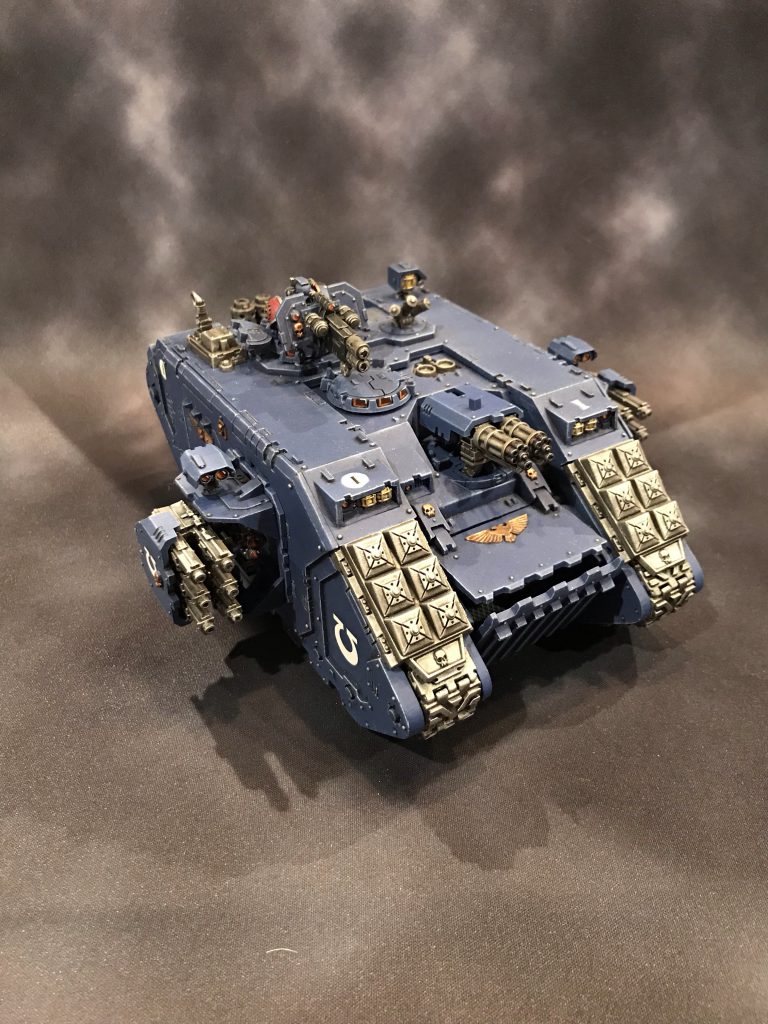
- Vindicator: The Demolisher Cannon was upgraded to have a flat D6 shots but loses the Linebreaker Bombardment stratagem. It’s a decent trade overall, as the updated Vindicator is much closer to something you’d consider, as the combination of Devastator Doctrine and the Big Guns Never Tire stratagem (which lets you ignore the penalty for moving and shooting) actually elevate the Vindicator to something more like a real threat.
- Centurion Devastators: Got the same +1W/+1A that the assault variant did. The +1W is quite a big deal here, as sniping these out with flat 3D weapons was the best way to deal with them, and they were already nearly good enough for competitive play.
Flyer
- Stormtalon: Dropped 10 points. It’ll really benefit from the Big Guns Never Tire stratagem and Devastator Doctrine. That may not be enough to get it into games, though.
- Stormhawk Interceptor: Gets a sidegrade – its halo launcher now gives units with FLY -1 to hit it rather than letting it re-roll save rolls of 1. That makes it a bit more vulnerable against volume low AP fire, but Alaitoc-level durable against any fellow flyers that want to shoot it. It’s also another big winner from the stratagem and Devastator Doctrine. Probably still a hint too expensive, but much closer to competitive.
Dedicated Transport
- Rhino: Rhinos came down 5 points. If you’re still using foot marines, hooray?
- Drop Pods: Aw, jeez. I was almost done with this article after something like 5,000 words on units when I get to the Drop Pod. The big change for Drop Pods is that Drop Pods and any units in them are exempt from the Tactical Reserves matched play rule, meaning:
- They can arrive on the battlefield during the first battle round
- They do not count as destroyed if they are not on the battlefield by the end of the third battle round
Also, depending on your interpretation of the rules, they may also be exempt from the part of the rule requiring you to set up at least half your army on the battlefield during deployment. It’s something Games Workshop is going to need to clarify.
But regardless of whether you can put your entire army in drop pods, this is a fundamental shift in the value of Drop Pods and as a result, the value of non-Primaris Marines. Being able to drop Marines all over the board on turn 1 has tremendous tactical value, forcing your opponent to deal with threats where they are most vulnerable immediately. Combined with the Phobos units, this gives Marines a really aggressive edge, where the army is able to pressure you in your deployment zone immediately. The best combinations here are likely Grav-cannon Devastators and Sterngard Veterans, who can use the Devastator and Tactical Doctrines to do severe damage to an unprepared opponent.
Likewise, don’t sleep on the prospect of empty pods. Being able to drop empty drop pods on every objective in the first turn of a game is a great way to force an opponent to waste fire destroying a bunch of T6, 8W fortifications that are holding every objective outside their deployment zone, or else find themselves down 3-4 points on turn 1. Similarly, saving a drop pod for turns 5 or 6 to put on an unheld objective is now an option for Marine players, particularly if you went second.
Wings Note: I think dropping empty ones on turn 1 is probably too cute – most armies at near full operation are going to be able to brush them off the board. Saving a singular one for an objective grab around turn 4 when both armies are looking battered, however, I like a lot.
Naramyth Note: You also have to be very careful dropping these near the enemy early. If you let your opponent tag them in melee, it can protect them from your shooting for a turn.
While these may not be “every game” strategies, they’re certainly options that you can consider and evaluate over the course of the game.
What’s Next
That does it for Part 2. In Part 3, we’ll cover Stratagems, Relics, Warlord Traits, and general tactics and strategies for playing with Space Marines.
